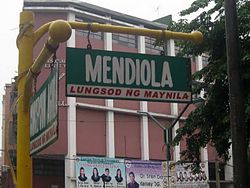- Mendiola Street
-
Mendiola Street 
A street sign at the north side of Mendiola corner Concepcion Aguila Streets.Length: 0.5 km (0.3 mi) From: Intersection of Legarda Street and Claro M. Recto Avenue in San Miguel, Manila To: Jose P. Laurel, Sr. Street in San Miguel, Manila Mendiola Street is a short thoroughfare in the district of San Miguel in Manila, Metro Manila National Capital Region, the Philippines. It is named after Enrique Mendiola, an educator, textbook author and a member of the first Board of Regents of the University of the Philippines, and being close to Malacanang Palace, the President's official residence, has been the site of numerous and sometimes bloody demonstrations.
The street crosses the Mendiola Bridge, officially known as Chino Roces Bridge in honor of Chino Roces, a well-known Martial Law figure (although an illuminated street sign above the intersection of Recto and Mendiola erroneously calls the place Chino Roces Avenue).
Mendiola Street starts at the intersection of Legarda Street and Claro M. Recto Avenue, and ends at Jose Laurel Street, just outside Malacañang Palace. Mendiola Street is the site of some colleges and universities that form the University Belt.
To protect Malacañang Palace, authorities decided to close the part of Mendiola Street that starts at the sentinel gate in front of the College of the Holy Spirit and La Consolacion College. Vehicles were then diverted to Concepcion Aguila Street, a narrow side street that passes through residential areas of San Miguel.
Contents
Protests
Mendiola Street has been the frequent site of often violent confrontations between protesters and government troops:
1970
During the administration of Ferdinand Marcos, Mendiola Street was the site of the "Battle of Malacañang" or "The Battle of Mendiola Bridge" on January 30, 1970 which resulted in the deaths of four student demonstrators.
1987
On January 22, 1987, crowd control troops opened fire on a protest rally of about 10,000 peasant farmers demanding genuine land reform from then President Corazon Aquino. Thirteen of the protesters were killed and hundreds injured in the incident now called the Mendiola massacre.
2001
On May 1, 2001, supporters of President Joseph Estrada, angered by his arrest following his ouster from power earlier that year, marched to Mendiola Street after staging demonstrations outside the EDSA Shrine demanding the release of Estrada. A violent confrontation ensued between Estrada supporters and members of the Philippine National Police and the Armed Forces of the Philippines, who were then tasked by President Gloria Macapagal-Arroyo to secure Malacañang Palace and the areas surrounding it. Mendiola Street and the vicinity around Malacañang Palace became a front line after the protesters tried to storm the Palace. Casualties were high on both the Estrada supporters and government troops. Damage to property along Mendiola Street and areas within the vicinity of Malacañang Palace cost millions of pesos as a result of looting of stores and shops and burning of several government and private vehicles by the protesters. Later, President Gloria Macapagal-Arroyo declared a State of National Emergency but lifted it after two days.
External links
Categories:- Roads in Manila
Wikimedia Foundation. 2010.
